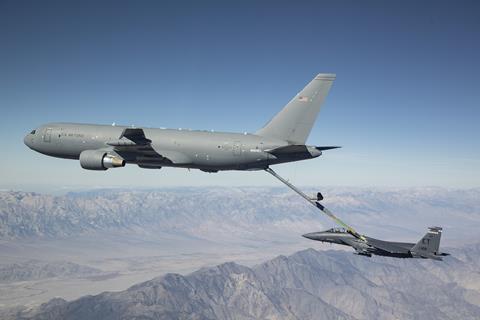The US Air Force (USAF) aims to fly a stealthy in-flight refuelling aircraft by the early 2030s, a goal that seemingly puts the project’s development ahead of previous plans.

USAF secretary Frank Kendall disclosed the 2030s goal to lawmakers on 2 May, saying the approach aligns with a broader shake up of USAF procurement plans.
In January, the USAF had unveiled a project to develop its Next Generation Air-refuelling System (NGAS) – a clean-sheet tanker aircraft with low-observability. A related request for information (RFI) put the new tanker’s initial operational capability milestone at 2040.
“It won’t be 2040 – it’s going to be much sooner than that,” Kendall said during a 2 May congressional budget hearing. “We want to get to that design as quickly as we can.”
Kendall hopes production will start soon enough that the USAF can begin fielding the tanker by the early 2030s. He adds that such a timeline remains aspirational until the service better defines the aircraft and its capabilities.
“We’ve fundamentally changed our tanker acquisition strategy,” Kendall says. “We need to move to a next-generation tanking capability that is resilient enough to survive against a pacing challenge.”
“Pacing challenge” is Pentagon-speak for strategic threats facing the USA. Almost universally, lawmakers and defence officials consider such threats to come from China.
With a handful of Chengdu J-20 fifth-generation fighters, hundreds of fourth-generation J-10, J-11 and J-16 fighters, and deep reserves of precision missiles, China’s People’s Liberation Army Air Force (PLAAF) poses significant challenges to Washington and its allies in the Indo-Pacific region.
The vastness of the western Pacific Ocean – where forward air bases can be hundreds or thousands of kilometres from both reinforcements and potential targets – make aerial refuelling an essential capability for the USA.
“Our tankers are very important to be able to generate our combat power,” USAF chief of staff General Charles Brown said during the 2 May hearing.
The service’s NGAS RFI asked defence companies to address “employment in contested scenarios” and threat-avoidance features to “reduce risks for both refueller and receiver [aircraft] in combat scenarios”.
The service wants bidders to propose designs that are more capable than existing Boeing KC-135 and KC-46 tankers, and that can be integrated into airspace management for “information-sharing, networking and shared-situational awareness”.
While not specifying design or performance requirements, the RFI is a USAF tool to help it assess potential capabilities as it develops the NGAS concept.
Kendall’s comment about fundamentally altering the USAF’s tanker strategy refers to a push by the service to speed up development and acquisition of military equipment.
The service is now purchasing and fielding KC-46s as stopgaps – those jets are allowing the USAF to modernise its fleet of ageing KC-135s and KC-10s prior to receiving the NGAS jets. Despite numerous engineering challenges and billions of dollars in penalties charged to Boeing, the USAF in 2022 cleared KC-46s for full operational duty worldwide.
Service leaders had previously planned to develop a so-called “bridge tanker” known as KC-Y to fill the gap between the end of KC-46 procurement and first NGAS deliveries. Lockheed Martin’s LMXT – based on the Airbus A330 Multi-Role Tanker Transport – was widely seen as the frontrunner for the programme.

However, fiscal year 2024 USAF budget documents and official statements indicate the service will likely drop the KC-Y development plan, choosing instead to purchase more KC-46s and accelerate NGAS development.
“The information that industry has previously provided… may lead us towards KC-46 [as] the answer,” Andrew Hunter, chief of acquisitions for the USAF, said at an Air and Space Forces Association conference in Colorado in March.
The decision could ultimately result in an additional 75 KC-46 orders for Boeing.
The FY2024 USAF budget request asks for funding to begin NGAS procurement, including for analysis of alternative options and for defining design requirements.
Kendall tells lawmakers that even with an accelerated timeline, the service faces a gap between when NGAS production begins and when its KC-46 acquisition contract options expire.
“We’d like to make that gap as small as possible,” he says.
Although the NGAS concept remains in early stages, indications suggest the aircraft will not be a modified or re-purposed commercial aircraft like the KC-46, which is based on Boeing’s 767 passenger jet.
“Traditionally, we could take a commercial grade of aircraft and turn it into a tanker or transport,” Kendall said of tankers during congressional testimony in January. “They’re not designed with a high set of requirements for survivability or resilience, and the threats are taking that freedom away from us.”


























